
'TGvultl/ ,kB CÆidiUr, del a htit
ACCENTOR MONIANEIJJTS .
Whiter,Jin/.
ACCENTOR MONTANELLUS.
Mountain Accentor.
Motacilla montanellus, Pall. Zoog. Rosso-Asiat., tom. i. p. 471, pi.—Id. I tin., tom. iii. p. 695. no. 12.
— montanella, Gmel. edit. Linn. Syst. Nat., tom. i. p. 968. no. 99.
Sylvia montanella, Lath. Ind. Om., vol. ii. p, 526.
Accentor montanellus, Temm. Man. d’Orn., 2nd edit., tom. i. p. 251, tom. iii. p. 174, and Atlas, pi. of male.—Bree’s
Hist, of Birds of Eur. not obs. in Brit. Isl., vol. ii. p. 115.—Bonap. Consp. Gen. Av., tom. i. p. 305,
Accentor, sp. 8.—Midd. Sib. Reise, tom. ii. p. 172.—Gould, Birds of Eur., vol. ii. pi. 101.—Gray and
Mitch. Gen. of Birds, vol. i. p. 187, Accentor, sp. 6.
— Temmincki, Brandt, Bonap. Consp. Gen. Av., tom. i. p. 306, Accentor, sp. 9.
— - (Spermolegus) Temminckii, G. R. Gray, Hand-list of Birds, part i. p. 230.
( -------------- ) montanellus, G. R. Gray, Hand-list of Birds, part i. p. 230.
Spermolegus montanellus, Kaup.
Siberian Warbler, Lath. Gen. Syn.,vol. iv. p. 456.—Shaw’s Gen. Zool., vol. x. p. 626.—Lath. Gen. Hist.,vol. vii. p. 90.
T h e figures of this bird on the opposite Plate were taken from Lake-Baikal specimens, which appear
to have been killed in their full nuptial dress, since they differ considerably from examples obtained in
other districts, yet not more than might be expected from individuals killed after the plumage had been
exposed to the light and temperature of the lofty regions in which they dwell.
The Accentor montanellus is most nearly allied to the bird named A . atrogularis by M. Brandt, of which a
figure will be found in the present work ; but the latter is somewhat larger in size and has a black throat,
which the former never has.
The following brief notes comprise all the information that has been recorded respecting this interesting
species :—
Temminck states that it inhabits Siberia, European Russia, the eastern parts of the middle of Europe, and
the same latitudes in Asia, that it is common in the Crimea in winter, and that it occurs in Dalmatia,
Hungary, and, less frequently, in the centre of Italy. He adds :— “ The individuals procured by Pallas do
not differ from those killed near Naples- I t always lives among the mountains, and does not visit the
plains, even in winter.”
“ All the adult specimens received by me from Lake Baikal,” says Mr. Swinhoe, “ are in full summer
dress ; it would appear, therefore, that the bird breeds in that neighbourhood, and migrates southward in winter ;
for, according to Père David ( ‘ Nouvelles Archives,’ tom. iii. p. 32), it only occurs at Peking during the season
of the great cold. It has not been found elsewhere in China. Von Schrenck does not mention it in his
‘Vôgel des Amur-Landes ;’ Radde procured it in Mongolia; Middendorff obtained a single specimen in the
Stanowoj mountains, and says that it agrees with Pallas’s description and Gould s Plate in the ‘ Birds
o f Europe.’ He does not believe Accentor Temmincki, Brandt, to be distinct, but declares that it is the
winter plumage of the ordinary bird.”
Dr. Bree states that the egg of this species, figured in his ‘ History of the Birds of Europe not observed
in the British Isles,’ was kindly sent to him “ by Professor Moquin-Tandon, with the following remarks :—
‘ My two eggs of this bird are exactly alike in shape and colour; they are twenty-three millims. in long
diameter, and sixteen in the short. The colour pale and uniform azure blue. They were were taken in
the south of Hungary, and sent to me by my friend, M. Raoul de Baracé d’Angers.’ ”
Crown of the head brownish black, somewhat lighter in the centre ; over each eye a broad stripe o f sandy
buff ; lores, lines under the eye, and ear-coverts brownish black, a few of the feathers covering the ears tipped
with buff, forming a spot within the black ; on each side of the neck a patch o f grey ; all the upper surface
reddish brown, with a stripe of brownish black down the centre of each feather ; wing-coverts reddish brown,
deepening into brownish black near the end and tipped with white ; remainder of the wing and the tail dark
brown with lighter margins, and a few of the innermost secondaries tipped with white ; under surface deep
buff, becoming gradually paler towards the vent, and streaked on the flanks with deep brown ; bill blackish
brown, tip yellow a t the base ; legs buff.
The lower figure in my Plate would appear to be that of a female ; the upper one probably represents a
adult male ; both of the natural size.